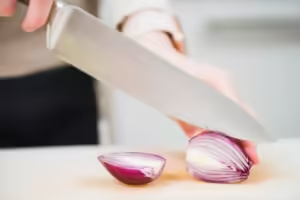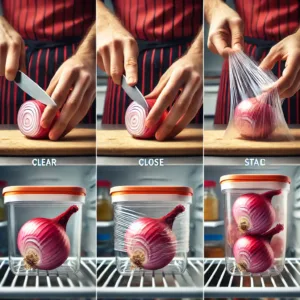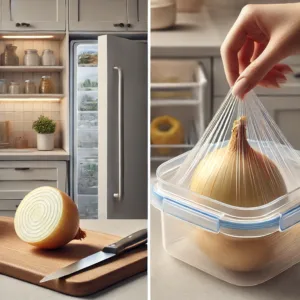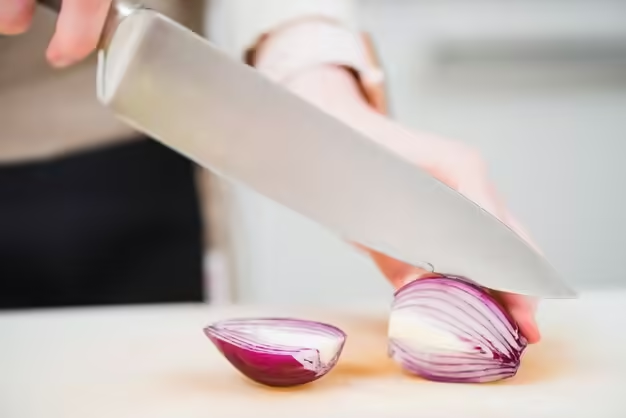I’ve tried and tested several methods over the years, and I’m excited to share what I’ve learned about how to store a cut onion with you.
Onions are one of those ingredients I can’t seem to cook without. Whether it’s a soup, stir-fry, or salad, onions always seem to make their way into my recipes.
But here’s the catch: more often than not, I find myself needing only half an onion.
I used to throw the leftover half into the fridge and hope it would last until the next time I needed it, but it never did.
It would dry out, lose its flavor, or worse, stink up my entire fridge. That’s when I decided to figure out how to store a cut onion properly, and let me tell you, it’s been a game changer.
If you’ve ever wondered how long you can keep a cut onion fresh or whether there’s a “right” way to store it, you’re in the right place.
Why Storing a Cut Onion Matters

Before we dive into how to store a cut onion, let’s talk about why it’s important. Onions have a high water content, and once you cut them, they start losing moisture.
This causes the onion to dry out, become rubbery, and lose its flavor. But that’s not the only problem.
When exposed to air, a cut onion also releases sulfur compounds, which are responsible for that strong onion smell we all know so well.
If left uncovered, your entire fridge can end up smelling like onions.
But it’s not just about the smell—there’s also the issue of food safety. Improperly stored onions can develop bacteria and mold, making them unsafe to eat.
That’s why learning how to store a cut onion properly is essential. You’ll not only extend its shelf life but also ensure it stays fresh and flavorful for your next meal.
How to Store a Cut Onion

Step 1: Airtight Containers Are Your Best Friend
The first thing I learned about how to store a cut onion is the importance of using an airtight container.
After trying several different methods, I found that keeping a cut onion in an airtight glass container is one of the best ways to prevent it from drying out.
I love using glass containers because they don’t absorb odors like plastic does, but if you only have plastic containers, they’ll work just fine too—just make sure they seal tightly.
By limiting the onion’s exposure to air, you can keep it fresh for up to a week.
This simple step has saved me countless onions from drying out prematurely and has also helped keep my fridge odor-free.
If you’re wondering how to store a cut onion without making your fridge smell, this is one of the best solutions.
Step 2: Wrapping It Properly
Before I discovered the magic of airtight containers, I used to wrap my cut onions in plastic wrap or aluminum foil.
While this method isn’t as effective as using a container, it’s still a good option if you don’t have one on hand.
The key is to wrap the onion tightly to minimize air exposure.
I’ve found that wrapping the onion in plastic wrap works best for short-term storage, especially if you plan on using it within a few days.
Just make sure the cut side is completely sealed.
Aluminum foil is another option, though I tend to prefer reusable beeswax wraps these days.
Beeswax wraps are eco-friendly and do a great job of keeping the onion fresh. So if you’re exploring different ways of how to store a cut onion, wrapping is a solid alternative to containers.
Step 3: Keep It in the Fridge’s Crisper Drawer
Here’s something I didn’t know for a long time: where you store your onion in the fridge matters.
For the longest time, I used to leave my cut onions on the top shelf of my fridge.
I didn’t think it made much of a difference, but it turns out the crisper drawer is the best place for them.
The crisper drawer is designed to maintain humidity, which is key to keeping onions from drying out.
Once I started placing my cut onions in the crisper drawer, I noticed a significant difference in how fresh they stayed.
If you’re looking for the most effective way how to store a cut onion, fridge placement is crucial.
Make sure to put your onion in the crisper drawer, and you’ll see how much longer it lasts compared to leaving it on any random fridge shelf.
Step 4: Freeze It for Later Use
What if you’ve cut more onion than you’ll use in the next few days?
Freezing might be the answer. I used to think onions couldn’t be frozen, but boy was I wrong.
Now, freezing has become one of my go-to solutions for long-term storage.
Here’s how I do it:
After cutting the onion, I chop it into smaller pieces and spread them out on a baking sheet.
I freeze them for about an hour, just long enough for the pieces to solidify.
Then, I transfer the frozen onion pieces into a freezer-safe bag. This way, they don’t stick together, and I can easily grab a handful when I need them.
Now, frozen onions won’t have the same crisp texture as fresh ones, but they work perfectly in cooked dishes.
If you’re looking for a way to make your onion last even longer, freezing is the way to go when figuring out how to store a cut onion.
Step 5: Avoid These Mistakes
Storing cut onions properly isn’t hard, but there are some common mistakes you’ll want to avoid.
Don’t leave it uncovered:
One of the biggest mistakes I used to make was leaving my cut onion uncovered in the fridge.
Doing this not only causes the onion to dry out but also allows its strong odor to permeate your entire fridge.
Don’t use a loose plastic bag:
A plastic bag might seem like a quick fix, but if it’s not sealed tightly, air will get in, and your onion will go bad faster.
Keep onions and potatoes separate:
I used to store onions and potatoes together, not realizing that this was a big mistake.
This is a weird one, but onions and potatoes produce gases that cause each other to spoil faster.
I used to store them together, and my onions went bad within days. Now, I make sure to keep them in separate areas of the kitchen.
By avoiding these mistakes, you can make sure that you’re maximizing the freshness of your cut onions.
If you’re still wondering how to store a cut onion, avoiding these common pitfalls is a big part of the solution.
Fun Facts About Onions
To make this post a little more interesting, let’s dive into some fun facts about onions!
Ancient Egyptians considered them a symbol of eternity because of their circular layers. Plus, onions are packed with vitamins and antioxidants, making them a powerhouse ingredient for your meals.
One interesting fact I discovered while learning how to store a cut onion is that the sulfur compounds in onions are what cause your eyes to tear up when you cut them.
These same compounds are responsible for the strong smell and taste that we associate with onions.
Keeping these compounds from oxidizing is key to preserving the onion’s flavor.
Recipes to Use Leftover Onions
Once you’ve mastered how to store a cut onion, you’ll probably have more leftover onions on hand than you know what to do with.
Caramelized Onions:
Slow-cooked caramelized onions are a fantastic way to use up leftover onion halves. You can use them as a topping for burgers, sandwiches, or even pizzas.
Onion Soup:
A hearty onion soup is a classic dish that makes great use of leftover onions. Just chop up your stored onions and let them simmer with broth for a comforting meal.
Stir-Fries:
Onions are a must-have ingredient in any stir-fry. Just toss your stored onion slices in with some vegetables and meat for a quick and easy dinner.
My Go-To Methods for How to Store a Cut Onion
By now, I hope I’ve made it clear that how to store a cut onion doesn’t have to be complicated.
With a few simple methods, you can keep your cut onions fresh, flavorful, and ready for your next meal.
Whether you’re using airtight containers, wrapping them tightly, or even freezing them, these methods are tried-and-true in my kitchen.
The next time you find yourself with half an onion, don’t just toss it into the fridge haphazardly.
Take a few extra seconds to store it properly, and you’ll be amazed at how much longer it lasts.
Trust me, I’ve been there—learning how to store a cut onion will save you time, reduce waste, and make your cooking experience that much better.
So, give these tips a try and let me know how they work for you.
Whether it’s a simple wrap, a handy container, or a quick freeze, there’s no shortage of ways to master how to store a cut onion.
Frequently Asked Questions (FAQ)
When it comes to understanding how to store a cut onion, people often have various questions.
Q1: Can I leave a cut onion at room temperature?
A: While it might be tempting to leave a cut onion on the kitchen counter, it’s not the best idea. Onions contain moisture, which means they can spoil quickly if left out. Bacteria thrive in warmer temperatures, so it’s always best to refrigerate a cut onion as soon as possible. This ensures it stays fresh longer and prevents it from spoiling.
Q2: Should I peel the onion before storing it?
A: If the onion is already peeled, store it as is. However, if part of the onion still has the peel on, keep it intact! The peel helps preserve moisture and acts as a natural barrier to bacteria. When you figure out how to store a cut onion, retaining its peel is one of the simplest ways to increase its shelf life.
Q3: Is it safe to eat a slimy onion?
A: No, if the cut onion becomes slimy or starts to develop a strange odor, it’s time to throw it out. This indicates bacterial growth or that the onion is past its prime. Always check for texture and smell before using stored onions.
Q4: Can cut onions make other food in my fridge smell?
A: Yes, onions release sulfur compounds that can easily transfer their smell to other food items in your fridge. This is why proper storage is critical. Using airtight containers or tightly wrapping the onion is the best way to avoid that infamous onion smell from permeating your entire fridge.
Q5: How do I prevent my eyes from watering when cutting onions?
A: While this isn’t directly related to how to store a cut onion, it’s a question many people ask! One trick I’ve learned is to chill the onion before cutting it. Cold onions release fewer of the compounds that irritate your eyes. You can also try cutting the onion near running water or using a sharp knife to minimize cell damage. And as always, be careful with your hands—don’t touch your eyes after handling onions!
Creative Ways to Use Stored Onions
Now that we’ve mastered how to store a cut onion, you might find yourself with leftover onions ready to be used in creative ways. Here are a few of my favorite ideas that go beyond the basics:
Caramelized onions
This is a fantastic way to use up stored onions.
Cook them slowly over low heat in a bit of butter or olive oil until they turn a rich, golden-brown color.
They’re perfect for topping burgers, adding to sandwiches, or mixing into pasta dishes. The sweetness of caramelized onions makes them a hit in any meal, and they store well in the fridge for several days.
Pickled Onions
if you’re looking for a way to preserve onions and add some tang to your meals, pickling is a great option.
Simply slice the onions thinly, pack them into a jar, and cover them with a mixture of vinegar, sugar, salt, and water. After a few hours, you’ll have a batch of delicious pickled onions that can be stored in the fridge for weeks.
They’re a great addition to tacos, salads, and sandwiches.
Onion Relish
Turn your stored onions into a flavorful relish by cooking them down with vinegar, sugar, and spices.
Onion relish is fantastic as a topping for grilled meats or served with cheese and crackers.
It’s a simple way to elevate your cooking and make use of onions that have been sitting in the fridge for a while.
The Importance of Proper Storage for Other Vegetables

While we’re focusing on how to store a cut onion, it’s worth noting that many of the principles apply to other vegetables as well.
Proper storage techniques can make a huge difference in the longevity and quality of all your fresh produce.
For example, just like onions, garlic should be stored in a cool, dry place. Peppers and cucumbers do well in the crisper drawer of the fridge, while tomatoes are best stored at room temperature until fully ripe.
Learning how to store different types of produce can help reduce food waste and ensure that your meals are always made with the freshest ingredients.
How to Store Onion Varieties
Different types of onions have slightly different storage needs. While we’ve been discussing how to store a cut onion, it’s helpful to understand how to store different varieties:
Yellow Onions:
These are the most common and can be stored similarly to the methods mentioned above. Yellow onions last longer than other types due to their thicker skin.
Red Onions:
These onions tend to be a bit more delicate, so if you’re storing a cut red onion, be sure to keep it tightly sealed. Red onions are also great for pickling, so if you have extra, consider that option.
A Final Word
Figuring out how to store a cut onion has been a game-changer for me in the kitchen.
Once I got the hang of it, I noticed a huge difference in both the freshness of my onions and the overall efficiency of my meal prep.
No more wasted onions, no more overpowering smells in the fridge, and no more worrying about food safety.
Whether you’re placing your cut onion in an airtight container, wrapping it up tightly for short-term use, or freezing it for later, these methods are simple and effective.
Proper storage ensures that you’re getting the most out of your ingredients, cutting down on waste, and always having fresh onions ready for your favorite recipes.
In the end, mastering how to store a cut onion is one of those small kitchen skills that makes a big impact.
It’s a lesson I’ve learned through years of trial and error, and I hope these tips help you as much as they’ve helped me.



